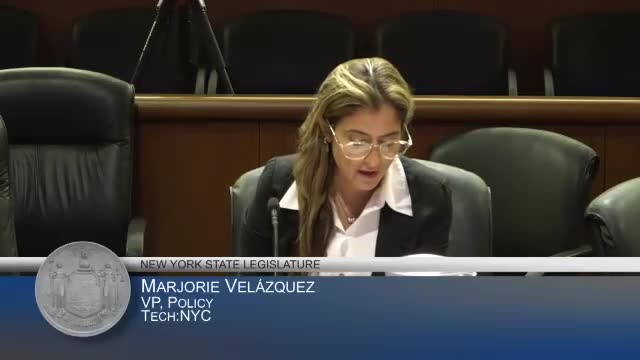Tech NYC urges New York legislators to adopt unified AI regulations aligned with Local Law 144
September 20, 2024 | Consumer Affairs and Protection, Standing Committees, House, Legislative, New York
This article was created by AI summarizing key points discussed. AI makes mistakes, so for full details and context, please refer to the video of the full meeting. Please report any errors so we can fix them. Report an error »

On September 20, 2024, the New York State Legislature convened to discuss critical measures aimed at ensuring consumer protection and safety in the rapidly evolving landscape of artificial intelligence (AI). The meeting highlighted the significant growth of AI technologies in New York, where over 1,000 AI-related companies have raised $27 billion since 2019, and more than 40,000 professionals are employed in the sector.
A key focus of the discussions was the need for cohesive regulations that align with existing local laws, particularly New York City’s Local Law 144, which mandates bias audits and disclosures for AI tools used in hiring. Advocates from Tech NYC urged the state legislature to adopt similar regulations statewide to avoid discrepancies that could burden companies operating in both the city and the broader state. They emphasized that a unified approach would streamline compliance and enhance the effectiveness of bias audits, which have emerged as a new category of assessments by accounting firms.
The meeting also addressed the importance of a risk-based regulatory framework for AI technologies. This approach would categorize regulations based on the potential risks associated with AI applications, particularly those that significantly impact consumers' lives, such as healthcare and financial decisions. By mirroring the European Union's tiered AI regulations, New York could ensure that the most sensitive applications receive the highest level of oversight while allowing less impactful uses of AI to flourish without excessive administrative burdens.
Furthermore, the discussions underscored the necessity of maintaining human oversight in AI decision-making processes. Stakeholders argued that as AI tools become more integrated into everyday business operations, it is crucial to establish clear responsibilities among developers, providers, and end-users to ensure compliance and accountability.
The meeting also touched on the need for standards regarding content created with AI, particularly to combat misinformation and protect consumers from deceptive practices. Recommendations included requiring state agencies to implement content provenance and authentication standards, ensuring that any AI-generated content produced or published by New York State is clearly labeled.
In conclusion, the New York State Legislature's meeting on AI regulations highlighted the urgent need for comprehensive and coherent policies that protect consumers while fostering innovation. As AI technologies continue to evolve, the legislature faces the challenge of balancing regulation with the need for economic growth and technological advancement. The discussions set the stage for future legislative actions aimed at creating a safer and more equitable environment for AI development and use in New York.
A key focus of the discussions was the need for cohesive regulations that align with existing local laws, particularly New York City’s Local Law 144, which mandates bias audits and disclosures for AI tools used in hiring. Advocates from Tech NYC urged the state legislature to adopt similar regulations statewide to avoid discrepancies that could burden companies operating in both the city and the broader state. They emphasized that a unified approach would streamline compliance and enhance the effectiveness of bias audits, which have emerged as a new category of assessments by accounting firms.
The meeting also addressed the importance of a risk-based regulatory framework for AI technologies. This approach would categorize regulations based on the potential risks associated with AI applications, particularly those that significantly impact consumers' lives, such as healthcare and financial decisions. By mirroring the European Union's tiered AI regulations, New York could ensure that the most sensitive applications receive the highest level of oversight while allowing less impactful uses of AI to flourish without excessive administrative burdens.
Furthermore, the discussions underscored the necessity of maintaining human oversight in AI decision-making processes. Stakeholders argued that as AI tools become more integrated into everyday business operations, it is crucial to establish clear responsibilities among developers, providers, and end-users to ensure compliance and accountability.
The meeting also touched on the need for standards regarding content created with AI, particularly to combat misinformation and protect consumers from deceptive practices. Recommendations included requiring state agencies to implement content provenance and authentication standards, ensuring that any AI-generated content produced or published by New York State is clearly labeled.
In conclusion, the New York State Legislature's meeting on AI regulations highlighted the urgent need for comprehensive and coherent policies that protect consumers while fostering innovation. As AI technologies continue to evolve, the legislature faces the challenge of balancing regulation with the need for economic growth and technological advancement. The discussions set the stage for future legislative actions aimed at creating a safer and more equitable environment for AI development and use in New York.
View full meeting
This article is based on a recent meeting—watch the full video and explore the complete transcript for deeper insights into the discussion.
View full meeting
